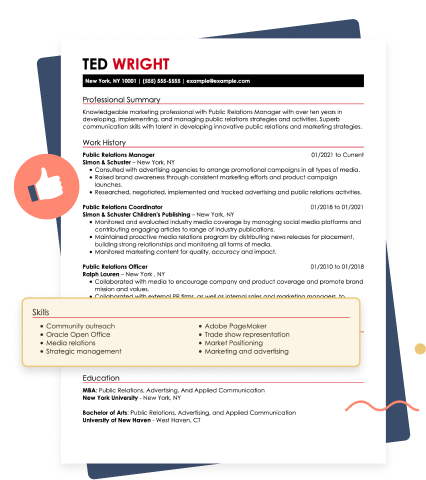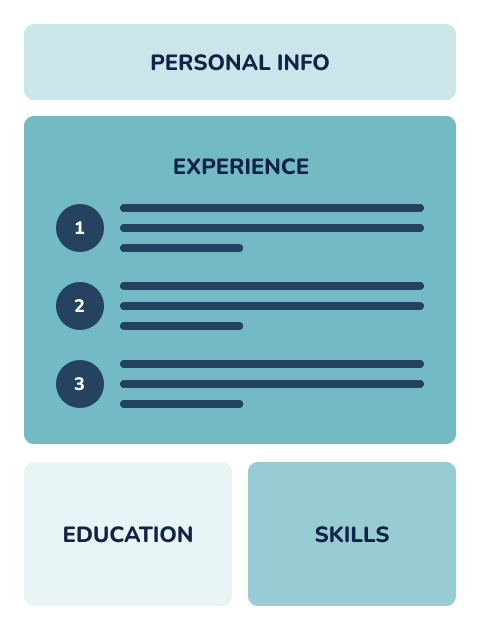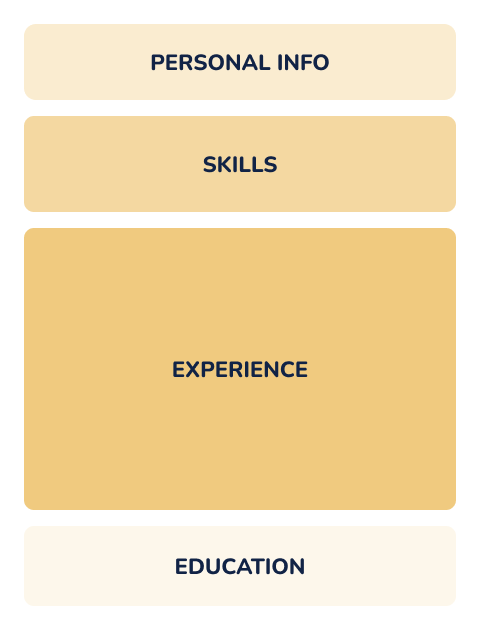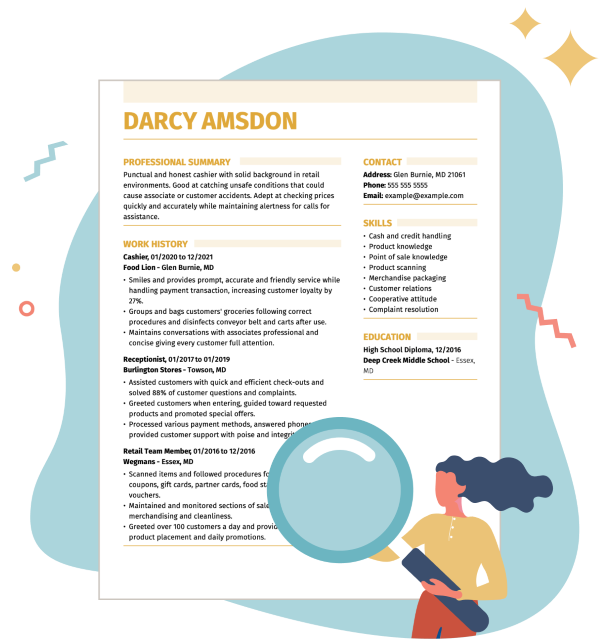Resume Tips for Older Workers: Examples & Guide

Our customers have been hired at: *Foot Note
If you’re over 50 and re-entering the workforce, or making a big career shift, a strong resume is crucial to help you emphasize strengths and minimize bias.
Our guide will walk you through strategies on how to create a resume, avoid ageism, and use your experience to your advantage, with examples tailored for experienced professionals. Whether you're re-entering the workforce or changing careers, we’ll help you make the professional resume you need.
Why Resume Strategy Matters As an Older Worker
While the experience you’ve accrued throughout your career is a major advantage, it won’t always be enough to get you the interview—especially when facing similarly experienced candidates or potential ageism. To stand out, you’ll need to be strategic about how you frame your experience on your resume.
For example, it's best to avoid adding your entire experience. Too long of a resume can work against you, especially when recruiters barely spend seconds scanning documents. You need to carefully select your most relevant qualifications and highlight your long career without making your decades of work the focus of your application.
Experience is good, but it's not the only factor helping you stand out. Direct attention to your current strengths by using the right strategies, such as:
- Showcasing recent accomplishments
- Highlighting modern, industry-relevant skills
- Including up-to-date certifications
- Emphasizing your ability to learn and adapt
Another consideration is to use modern resume styles and formats. Your resume is a reflection of your personal brand. If it appears outdated or generic, it may suggest that your approach to work is too. By aligning your resume with today’s expectations, you communicate that you're not just keeping up—you’re bringing hard-earned insight and a future-focused mindset to the table.
How to Write a Resume for Older Workers
You may wonder what’s so different about writing a resume as an older worker. After all, your experience also includes updating your resume and applying for many jobs throughout the years. However, the job search landscape changes with time, as does your positioning as a candidate.
Here are some tips to optimize your resume according to your age and experience.
Focus on the most relevant 10-15 years of work
It may be tempting to talk about all your experience and accomplishments throughout your career, all the way back to when you started. However, going too far and adding every single role could water down your resume and make it difficult to find the experience most relevant to the role you’re applying for.
If you intend to stay within the same industry, aim to showcase your last 10 to 15 years of work. You can certainly add previous experience to prove your tenure, but focus on diving deeper into recent roles to prove you’re up to date on the latest processes, research, software, or any valuable skills.
If, on the other hand, you’re making a big career change or going back to something you did a long time ago, you can choose other, older roles to highlight. Even then, it’s important to include recent experience to show how you’ve stayed active and what you could bring from other fields into the new job.
Prioritize accomplishments over tasks
With so much experience, it’s likely you’ve produced amazing results through your hard work. Highlight your most relevant and impressive accomplishments rather than just listing responsibilities to show the impact of your work.
Talk about the results of your efforts in quantifiable terms, for example:
Improved productivity within my team.
Improved productivity by 15% quarter to quarter.
Results will always paint a clearer picture of who you are as a potential employee.
But don’t leave out tasks entirely. Think about what tasks are important to the role you’re applying for. If they clearly depict the skills you possess and how you can incorporate them in a new job, make sure you list them as well. Ensure you make them as specific as possible to help employers clearly understand the depth of what you can do and what sets you apart as a candidate.
Highlight relevant skills
Choose the most relevant skills to include in your resume. Look at the job description and try to match it as best as you can with the skills you possess. Also, include skills relevant to the current state of the industry—such as proficiency with AI tools—and transferable skills that are valuable from one job to the next.
Including modern, in-demand skills shows hiring managers how you can contribute to today’s workforce, and that you’re a highly adaptable candidate.
Here are some examples of high-demand hard skills for today’s work environment:
- Proficiency in project management software (Asana, Jira, Scrum)
- Data analysis
- AI prompting
- Knowledge of SEO principles
- Cybersecurity awareness
Include ongoing learning and certifications
In order to show that you stay up to date in your industry, as well as with new tools and technologies, include ongoing learning and certifications you’ve acquired recently. Beyond showing that you’re up to date, it shows your willingness to learn, adapt, and work independently.
Focus on certifications directly tied to your industry or role, such as project management or relevant software training. This will boost your qualifications and help you stand out in fields that are rapidly evolving.
Address employment gaps
If you’re getting back into the workforce after a hiatus, you might want to address it to avoid any questions moving forward. There are a few ways you can approach discussing an employment gap:
- Briefly mention your reasons for leaving and returning to the workforce in your resume summary.
- Write a cover letter that briefly discusses what you did during that gap.
- Prepare yourself to talk about it in your interviews.
Talking about an employment gap provides a good opportunity to highlight other skills you possess or that you acquired during that time. You can also show how you’ve stayed active and up to date in the industry despite your distance from a traditional job.
Independence and initiative are very valuable to any employer, so use your gap to highlight these capabilities.
Use an ATS-friendly resume template
Nowadays, most companies use applicant tracking systems (ATS) to filter out applications and make it easier for hiring managers to assess candidates. Unfortunately, this means that many great candidates can miss out due to not having an ATS-friendly resume.
Elements such as an optimized resume summary, clearly divided sections, and keywords that match the job description are important to improve your chances of bypassing these systems. You can also look for ATS-friendly resume templates that have been pre-designed for this purpose, or use a resume builder to help you make a resume with these features.
Stick to two pages or less
A one-page resume is the usual standard. It’s concise, direct, and ensures the information it provides is easily scannable. Also, it helps avoid overstuffing the resume with irrelevant or unnecessary roles and tasks that could distract from the information you want hiring managers to see.
However, when you have over 20 years of experience, a lot of information might be relevant and valuable, especially if you’re applying for director and executive-level positions. In this case, making a two-page resume may be a better approach. To stick to a maximum of two pages, carefully select your most valuable roles, tasks, accomplishments, and skills.
One-page resume example for older workers
Two-page resume example for older workers
Choose the Right Resume Format
The right format structures your resume’s sections according to your career’s strengths, which helps tell your story clearly and professionally.
These are the main resume formats:
- Chronological resume: This format uses a reverse-chronological order and it’s used to emphasize work experience.
- Functional resume: The functional resume showcases skills, certifications, and other sections that show potential, especially for people with limited experience.
- Combination resume: It highlights both work experience and skills to strike the balance between what you’ve done and what you can do.
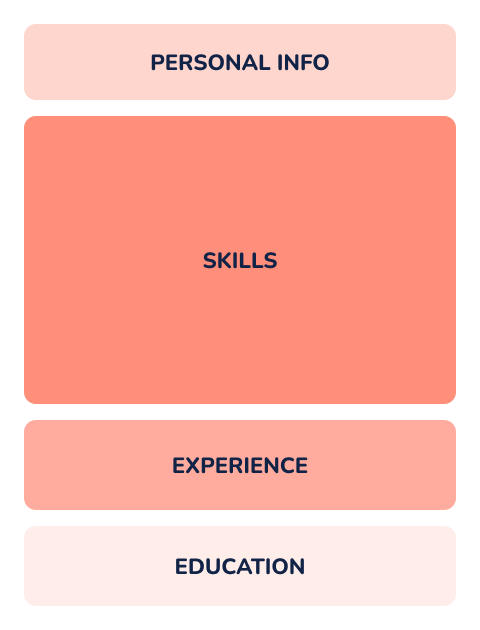
For older workers, the goal is to highlight strengths, mainly through your experience, while keeping the resume modern and easy to navigate for hiring managers. This makes the chronological resume the best resume format at this stage—unless you’re changing careers.
The reverse-chronological format puts your most recent experience at the top, making it easy to spot your career progression and strengths. Not only that, but it prioritizes work history overall, putting it front and center.
How to Protect Against Age Discrimination
Unfortunately, age bias still exists and may affect your opportunities. Thankfully, there are ways to tailor your resume that focus on your qualifications and take attention away from your age.
Leave off unnecessary dates
You can start by leaving off graduation dates; as long as your credentials are valid, there’s no need to include when you obtained your degrees. Also, leave out early roles, especially those that aren’t relevant at all.
It’s best to focus on the last 10-15 years, unless you’ve been in the same industry for a long time and feel that older experience is a valuable asset. Even then, be sure that the oldest position you add was a relevant or important position, such as when you first became manager.
Use the right language
Choose the correct words to describe your experience and track record. The best way to approach your time in the workforce is to talk about your accomplishments instead of focusing on how long you’ve worked as a signal of your value.
If you want to describe yourself as an experienced individual in your resume summary, for example, use phrases like “proven track record of [accomplishment]” or a specific span of years in which your work was highly relevant instead.
For example, instead of saying “Over 20 years of experience,” use a more specific phrase such as “10 years of management experience in a factory setting.” This highlights an important position and your experience within it, instead of a vague time frame.
This takes attention away from your age and redirects it to specific experiences while maintaining the core idea of your long track record at any given role.
Pro Tip:
Use our Resume Summary Generator to quickly create a customized professional summary based on your resume.
Highlight up-to-date knowledge and skills
A big part of age bias is thinking older workers aren’t familiar with modern-day tools and technologies. That's why it’s important to highlight the abilities and knowledge you do possess.
Depending on the type of work you do, and the role you’re applying for, highlighting these skills might even be more important than highlighting your years of experience. For example, you may want to:
- Prioritize detailing tasks and projects that include the use of modern tools, such as leveraging AI or optimizing processes through management systems.
- Mention certifications or overall knowledge of new security standards, operating procedures, or recent research, depending on your field.
- Include instances that show you’ve had to adapt to new systems. Include examples in your cover letter and be prepared to break it down in an interview.
Additional Job Search Tips for Older Workers
As a veteran in your field, you have many advantages beyond your skills and work experience, such as your professional network and your industry knowledge. Here are some additional tips to aid in your job search.
Use your network
Over the course of your career, you’ve likely made many connections that either do similar work or can help you find new paths. Look to these people for advice on how to make career changes, how to approach new hiring practices, or provide feedback on your resume.
Other people’s input can be highly valuable, especially if this is the first time you’ve looked for a job in many years. They could also know about other opportunities that aren’t easily found online, such as freelancing opportunities or new industries closely related to your own.
Take advantage of professional memberships
Professional associations, alumni groups, or industry memberships can be of great help. For one, they can boost your credibility and provide potential employers with more references beyond your past employers. This can help get your foot in the door.
Also, don’t hesitate to highlight leadership roles or active involvement in these groups. Many industries highly value these positions, as it shows commitment and passion for the field, as well as leadership and interpersonal skills.
Keep your online presence up to date
Professional online platforms, such as LinkedIn or Bold.pro, have become vital for modern-day job searching; from staying up to date on the latest industry trends to networking with a little help from the algorithm.
Keeping your profiles up to date attracts recruiters and hiring managers and gets them to contact you directly. In other words, it does some of the work for you. Update your jobs, share your accomplishments regularly, and spread your work to let potential employers see evidence of your success.
Final Resume Tips for Older Workers
As an older worker, you need to balance highlighting the advantages of having a long career with avoiding the unfortunate bias that can sometimes be seen throughout the job market. It all starts with crafting a good resume that can bypass ATS filters and communicate your qualifications effectively.
Keep in mind these final tips to make sure your resume is in tip top shape:
- Customize your resume for each application.
- Use job description keywords to improve ATS compatibility.
- Save and submit your resume as a PDF (unless told otherwise).
- Double-check for typos and formatting issues.
- Don’t downplay your experience—present it as the strength it is!
Key Takeaways
- Emphasize the most relevant 10-15 years of experience on your resume.
- Choose a chronological resume format with a clean, professional design.
- Highlight results and achievements, not just responsibilities.
- Include current tools, certifications, and training.
- Leverage your network and build a strong online presence.
FAQ
How many pages should a resume for older workers be?
Older workers have a lot of significant experience, especially when applying for high positions, meaning a two-page resume is acceptable as opposed to the usually recommended one page.
However, limiting it to one page can also benefit you, depending on the amount and type of experience. For example, if most of your relevant work history came from a single company or position, then a single page may be enough to cover your career highlights.
What are applicant tracking systems (ATS)?
Applicant tracking systems are software used by companies to filter applications and make the process more manageable for hiring departments. They use an algorithm based on the company’s requirements to weed out and rank candidates on factors ranging from location to specific skills.
This is why creating an ATS-friendly resume that clearly labels sections and matches important resume keywords from the job description is so important. Other information, such as your address, can also have an effect since location might be an important factor. For example, if you’re looking to relocate, use your target location instead of your current address; but be sure to be upfront about your intention to relocate if you get a call.
How far back should my resume go?
Generally, you shouldn’t go beyond 10-15 years, depending on the relevance of your experience. But if you have over 20 years of highly relevant experience and consider this to be your main advantage for a role, don’t be afraid to include it.
Our customers have been hired at:*Foot Note

